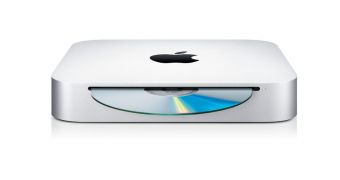The company headquartered at One Infinite Loop, Cupertino, California has posted a series of technical notes for future owners of its all-new Mac mini (Mid 2010), detailing some of this Mac’s particularities, like the external ports and connectors, power consumption, and thermal output (BTU) information.
For one reason or another, you may be required to locate the serial number of your new Mac mini. Apple has you covered with a support document explaining where to look, complete with imagery and a comparison between the old and the new Mac mini models. There are two ways to find the serial number on your computer, Apple reveals.
“On most computers with Mac OS X you can find the serial number in the About This Mac window. For more information on this, or if the serial number doesn't show in the About This Mac window, see About This Mac Window Provides Computer Serial Number,” Apple says. “To find the serial number on the base of the computer […] make sure all cords and connectors are unplugged from the Mac mini, then turn it over,” the Mac maker advises customers. “On Mac mini (Mid 2010), the serial number is printed on the metal frame without a bar code, as below,” Apple says, and shows a picture of the Mac mini’s under side.
Those looking for power consumption and thermal output (BTU) information can check out this tech note, which offers a chart of several Mac mini models, including the one Apple released yesterday. It starts out with this very configuration, saying that power consumption is as low as 10 Watts when Idle and 85 Watts when put to heavy work. Thermal output is between 34 BTU/h or 290 BTU/h in the same circumstances.
Talking about the computer’s external ports and connectors, Apple claims that, “All ports and connectors discussed in this article are located on the Input/Output (I/O) panel on the back of the computer.” A representation of the Mac mini is then offered, with every port highlighted and its purpose described.
“Mac mini (Mid 2010): Windows support for the SD card slot” introduces customers to using Microsoft Windows with the SD (Secure Digital) card slot in the new mini. According to the document in question, SDXC (Extended Capacity) cards are not supported in Windows at this time, while users cannot format an SD or SDHC (High Capacity) card as NTFS (New Technology File System) using Windows XP. Moreover, Windows XP cannot read an SD card formatted with the Mac OS file system, Apple claims. On occasion, FAT32 formatted SD cards may not appear in My Computer with Microsoft Vista 32-bit, should they not completely adhere to SD technical specifications. According to the troubleshooting steps offered by Apple, restarting the computer may help the SD card mount.
A new user’s guide is also available from Apple for Mac Pro and Mac mini computers. Entitled “Mac Pro & Mac mini Fast Start: The new user's guide to the Mac,” the document acts as a handy tool to help customers set up their computer.

 14 DAY TRIAL //
14 DAY TRIAL //